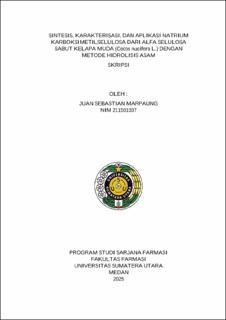Sintesis, Karakterisasi, dan Aplikasi Natrium Karboksimetilselulosa dari Alfa Selulosa Sabut Kelapa Muda (Cocos Nucifera L.) dengan Metode Hidrolisis Asam
Synthesis, Characterization, nd Application of Natrium Carboxymetyl Cellulose from Alfa Cellulose of Young Coconut Coir (Cocos Nucifera L.) by Acid Hydrolysis Methods

Date
2025Author
Marpaung, Juan Sebastian
Advisor(s)
Laila, Lia
Yuliasmi, Sri
Metadata
Show full item recordAbstract
Background: Utilization of waste by young coconut coir (Cocos nucifera L.) which
is still less optimized for maximum use. Young coconut coir have a high cellulose
content of 42,6% which can be optimized into pharmaceutical raw materials,
namely sodium carboxymethyl cellulose.
Objective: The research was conducted to synthesize and evaluate sodium
carboxymethylcellulose from young coconut coir alpha cellulose produced by acid
method isolation.
Method: The research was conducted to synthesize and evaluate the method of
isolating alpha cellulose which was carried out by pre-treatment process with
varying concentrations (2,5%, 3,0%, 3,5%) of HNO3 then swelling process with 2%
NaOH and 2% Na2SO3, bleaching process with 2% H2O2 and 10% H2O2 and the
results obtained were purified with 17,5% NaOH to separate alpha-cellulose. The
results of alpha-cellulose isolation were alkalized and carboxymethylated and then
applied to pharmaceutical preparations, namely gels.
Results: In the results of the isolation of young coconut fiber alpha cellulose, the
highest yield was obtained in HNO3 3,5%, namely 12,37 ± 2,23% with the results
of odorless, tasteless and white powder. The FT-IR results showed that HNO3 3,5%
has a wave number match on the expected functional groups. SEM results obtained
in the form of clear fibers microfibrils in accordance with commercial cellulose.
The results of the synthesis of Na-CMC young coconut fiber produced a yield value
of 11,23 ± 2,23%, the degree of substitution with a value of 0,2 swelling ratio value
of 18,43 ± 5,85% In the results of the preparation of Na-CMC young coconut fiber
gel obtained liquid preparation, yellowish white, not transparent and odorless, the
viscosity results of Na-CMC young coconut fiber gel 118,25 ± 1,08 c.Pas compared
to the use of commercial Na-CMC produced a viscosity of 19393 ± 106,7 c.Pas.
Conclusion: Acid hydrolysis with HNO3 can isolate alpha cellulose from young
coconut fiber (Cocos nucifera L.) but has not been able to produce effective raw
materials in the process of synthesizing sodium carboxymethylcellulose. The
results of the Na-CMC synthesis of young coconut fiber have not met the
characteristics of a good pharmaceutical preparation. The resulting gel preparation
has not met the characteristics and evaluation as a gel preparation.
Collections
- Undergraduate Theses [1833]
